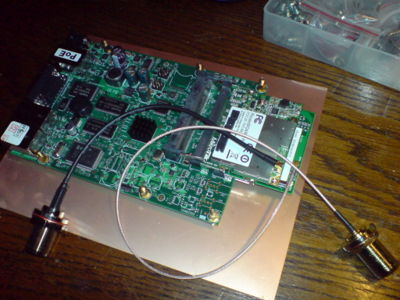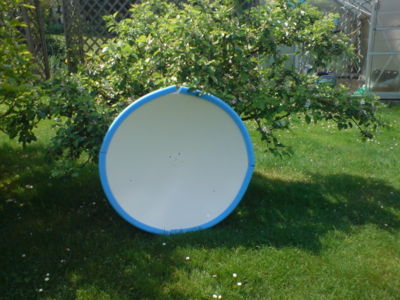High Performance WIFI link: Unterschied zwischen den Versionen
Dl8rds (Diskussion | Beiträge) |
Dl8rds (Diskussion | Beiträge) |
||
| Zeile 32: | Zeile 32: | ||
* http://wiki.oevsv.at/images/1/13/SetUpBB.pdf | * http://wiki.oevsv.at/images/1/13/SetUpBB.pdf | ||
* http://multimedia.oevsv.at/geiersberg2008/Projekt-Alan-DigitalerBackboneOE-VortragGeiersberg2008.ppt | * http://multimedia.oevsv.at/geiersberg2008/Projekt-Alan-DigitalerBackboneOE-VortragGeiersberg2008.ppt | ||
| + | |||
| + | == Some considerations== | ||
| + | === Using preamps vs. PAs === | ||
| + | In a discussion on Saturday 09.05.09 we found out that the receiver sensitivity of the WIFI cards we're using is far below all standards known for amateur radio devices. The dpecification says that the sensititivity is as low as -79 dB. As opposed to the transmission power and the prospected gains from the dish, the transmission path is not the side that will deserve our main attention: The reception path will promise the highest gains. | ||
| + | |||
| + | Since it was out initial plan to place the router board directly into the focus of the dish, we decided against it, on grounds that we intend to use a highly selective preamplifier, just in the focus of the dish. Given that, the router board doesn't need to be in the focus any longer. Having less weight out there with half a meter of leverage, our dish will also gain more mechanical stability. | ||
| + | |||
| + | So it will be the task of Bernd, DJ6PA, to construct the ring exciters and the pair of preamplifiers - one for 13cm and one for 6 cm. | ||
| + | |||
| + | Given that we will be using preamplifiers anyway, we can live with the 0.5 dB loss of the H200 cable that connects the preamp in the focus and the router board. | ||
| + | |||
| + | === Mechanical stability vs. propagation angle === | ||
| + | Our pair of dishes has a diameter of 1 meter. Sure, this will give us a gain of about 26 dB on the 6cm band and almost as much on the 13cm band. But such big dishes have a disadvantage: The propagation angle is extremely small. We calculate less tha 1 degree on 6 cm. The transmitted beam is thus very, very narrow. Since the dish is quite big nevertheless, it is very prone to vibrations caused by the wind. | ||
| + | |||
| + | With an estimated propagation angle of about 1 degree, in 30 kilometers distance the diameter of the beam will just be about 500 meters. So only slight vibrations of the mounts will cause the beam to be off the target. It will be vital for a stable link to mount the disk as mechanically stable as possible, and not just on one side, but on two sides. | ||
| + | |||
| + | As for the next milestone of the project, to set up a link over 30 kilometers, it might be more advisable to try a smaller dish at first. This is also an interesting insight given that we have established connections on 10 GHz between DB0MHB and stations in Regensburg using far less transmitting power and smaller dishes. | ||
== Installation == | == Installation == | ||
Version vom 10. Mai 2009, 16:16 Uhr
Inhaltsverzeichnis
1 Project goals
This is the master project of all these WIFI link projects. All the other projects only served for acquiring according knowledge, but this time, we'll do the real thing: Set up a link over 30 kilometers. Since we intend to connect DB0MHB with a high performance link to the AMPR Amateur Packet Radio network, we want to hook MHB to the Deutsches Forschungsnetz over the Fachhochschule Regensburg.
This project must be seen in the context of the southern German initiatives such as that of DARC district Oberbayern to extend the Austrian HAMNET into Germany. District Oberbayern has decided to spend some thousands of euros for buying the necessary hardware to establish a number of high speed links, using exactly the same hardware platform as we're doing. Lest, we're not extending the network from south to north, but we're establishing one single link from north to south. But we clearly support the idea that our networks are growing together, which will require some more investments by other carriers.
Precursors of this project are these projects:
2 Hardware
We have the same hardware on both sides:
- 1 meter diameter parabolic dish from Ebay
- Mikrotik RouterBoard 433
- WLM54SAG MiniPCI WLAN Interface
- R5H Mikrotik HighPower WLAN interface
- Custom Frequency License to transmit within the Amateur Radio bands
Cost estimate:
- dishes 60 Euro
- Router hardware 430 Euro
- several working hours
3 Software
Let me collect some links beforehand:
- http://wiki.oevsv.at/images/1/13/SetUpBB.pdf
- http://multimedia.oevsv.at/geiersberg2008/Projekt-Alan-DigitalerBackboneOE-VortragGeiersberg2008.ppt
4 Some considerations
4.1 Using preamps vs. PAs
In a discussion on Saturday 09.05.09 we found out that the receiver sensitivity of the WIFI cards we're using is far below all standards known for amateur radio devices. The dpecification says that the sensititivity is as low as -79 dB. As opposed to the transmission power and the prospected gains from the dish, the transmission path is not the side that will deserve our main attention: The reception path will promise the highest gains.
Since it was out initial plan to place the router board directly into the focus of the dish, we decided against it, on grounds that we intend to use a highly selective preamplifier, just in the focus of the dish. Given that, the router board doesn't need to be in the focus any longer. Having less weight out there with half a meter of leverage, our dish will also gain more mechanical stability.
So it will be the task of Bernd, DJ6PA, to construct the ring exciters and the pair of preamplifiers - one for 13cm and one for 6 cm.
Given that we will be using preamplifiers anyway, we can live with the 0.5 dB loss of the H200 cable that connects the preamp in the focus and the router board.
4.2 Mechanical stability vs. propagation angle
Our pair of dishes has a diameter of 1 meter. Sure, this will give us a gain of about 26 dB on the 6cm band and almost as much on the 13cm band. But such big dishes have a disadvantage: The propagation angle is extremely small. We calculate less tha 1 degree on 6 cm. The transmitted beam is thus very, very narrow. Since the dish is quite big nevertheless, it is very prone to vibrations caused by the wind.
With an estimated propagation angle of about 1 degree, in 30 kilometers distance the diameter of the beam will just be about 500 meters. So only slight vibrations of the mounts will cause the beam to be off the target. It will be vital for a stable link to mount the disk as mechanically stable as possible, and not just on one side, but on two sides.
As for the next milestone of the project, to set up a link over 30 kilometers, it might be more advisable to try a smaller dish at first. This is also an interesting insight given that we have established connections on 10 GHz between DB0MHB and stations in Regensburg using far less transmitting power and smaller dishes.
5 Installation
5.1 Burdens of the installation
Before you can get access to the device, you need a Nullmodem. I just followed the cabling instuctions given here and it worked from the beginning.
5.2 What's next?
don't know yet. Hold on.

